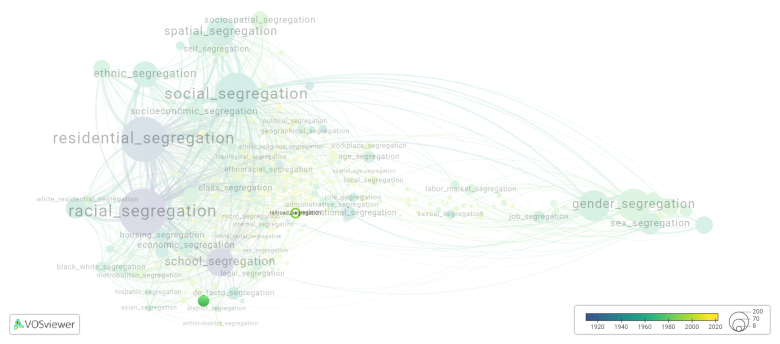Railroad segregation: Difference between revisions
(Creating page) |
(Creating page) |
||
| Line 14: | Line 14: | ||
Railroad segregation played a significant role in perpetuating racial inequality in the United States and contributed to the broader civil rights movement. It was a clear and tangible manifestation of the racial discrimination and prejudice prevalent at the time. | Railroad segregation played a significant role in perpetuating racial inequality in the United States and contributed to the broader civil rights movement. It was a clear and tangible manifestation of the racial discrimination and prejudice prevalent at the time. | ||
==See also== | ==See also== | ||
==Related segregation forms== | |||
Railroad segregation is frequently discussed in the literature with the following segregation forms: | |||
[[de jure segregation]] | |||
[[File:railroad_segregation.png|780x780px]] | |||
For the complete network of associated segregation forms, see: | |||
year of publication https://tinyurl.com/2235lkhw | |||
Louvain clusters https://tinyurl.com/2d8wg5n3 | |||
betweenness centrality https://tinyurl.com/223udk5r | |||
disciplines where segregation forms first appeared https://tinyurl.com/244d8unz | |||
==References== | ==References== | ||
==Notes== | ==Notes== | ||
Revision as of 14:38, 27 September 2024
Date and country of first publication[1]
1999
United States
Definition
Railroad segregation, also known as train segregation, was a systemic practice in the United States that separated passengers of different racial backgrounds on trains during the era of legal segregation. The practice began in the late 19th century and continued until the mid-20th century.
During this time, African Americans were often forced to ride in separate train cars designated for "colored" or "negro" passengers. These cars were usually inferior in quality compared to the ones reserved for white passengers. The segregated cars were cramped, poorly ventilated, and lacked basic amenities like comfortable seating, restrooms, or drinking water.
The segregation of railroad cars was implemented through state and local laws, as well as through company policies. In some regions, it was even illegal for black and white passengers to sit together in the same train car. Violating these laws could result in fines, imprisonment, or physical violence.
While segregation was officially abolished with the Supreme Court ruling in Brown v. Board of Education in 1954, it took several more years for the practice to be completely eradicated from railroad travel. The Civil Rights Act of 1964 outlawed segregation in all facilities open to the public, including trains, and effectively put an end to railroad segregation.
Railroad segregation played a significant role in perpetuating racial inequality in the United States and contributed to the broader civil rights movement. It was a clear and tangible manifestation of the racial discrimination and prejudice prevalent at the time.
See also
Related segregation forms
Railroad segregation is frequently discussed in the literature with the following segregation forms:
For the complete network of associated segregation forms, see:
year of publication https://tinyurl.com/2235lkhw
Louvain clusters https://tinyurl.com/2d8wg5n3
betweenness centrality https://tinyurl.com/223udk5r
disciplines where segregation forms first appeared https://tinyurl.com/244d8unz
References
Notes
- ↑ Date and country of first publication as informed by the Scopus database (December 2023).
At its current state, this definition has been generated by a Large Language Model (LLM) so far without review by an independent researcher or a member of the curating team of segregation experts that keep the Segregation Wiki online. While we strive for accuracy, we cannot guarantee its reliability, completeness and timeliness. Please use this content with caution and verify information as needed. Also, feel free to improve on the definition as you see fit, including the use of references and other informational resources. We value your input in enhancing the quality and accuracy of the definitions of segregation forms collectively offered in the Segregation Wiki ©.
Railroad segregation appears in the following literature
Mack K.W. (1999). Law, society, identity, and the making of the Jim Crow South: Travel and segregation on Tennessee railroads, 1875 1905. Law and Social Inquiry, 24(2), 377-409. Blackwell Publishing Inc..https://doi.org/10.1111/j.1747-4469.1999.tb00134.x

